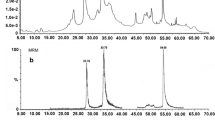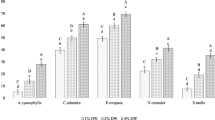Abstract
Numerous fungicide applications are often needed to control fungal plant pathogens, and consequently there is an increasing demand for alternative means to control them. Natural plant products are one of the most important alternatives which do not have any indiscriminate hazardous effects like synthetic products. In the present study, antifungal properties of water soluble, ethanolic and methanolic extracts taken from leaves, floral tissues, and seeds of wild rue (Peganum harmala L.) were tested on the mycelial growth and spore germination of Phytophthora drechsleri, Verticillium dahliae, Sclerotinia sclerotiorum, Cla-dosporium cucumerinum, Corynespora cassiicola, Alternaria sp., Ulocladium sp., Botrytis cinerea, Monosporascus cannon-ballus, Fusarium oxysporum f. sp. melonis, Macrophomina phaseolina, Rhizoctonia solani and Trichoderma harzianum. The water soluble extracts caused a significant decrease in the mycelial growth of the majority of fungi tested with maximum activity detected for seed extracts. Additionally, water soluble seed extract inhibited spore germination of Fusarium oxy-sporum f. sp. melonis. This study demonstrated the antifungal activity of P. harmala extracts on phytopathogenic fungi which can be used as an alternative for chemical compounds.
Zusammenfassung
Synthetische Fungizide werden weltweit zunehmend zur Kontrolle pflanzenpathogener Pilze eingesetzt, woraus ein steigender Bedarf an alternativen Bekämpfungsverfahren re-sultieren kann. Pflanzliche Naturstoffe stellen eine der erfolg-versprechendsten Alternativen zum chemischen Pflanzen-schutz dar, weil sie in der Regel geringere Nebenwirkungen zur Folge haben. Wir untersuchten die Wirkung wässriger, ethanolischer und methanolischer Extrakte von Blättern, Blüten und Samen der Steppenraute (Peganum harmala L.) auf das Myzelwachstum und die Sporenkeimung der pflanzen-pathogenen Pilze Phytophthora drechsleri, Verticillium dah-liae, Sclerotinia sclerotiorum, Cladosporium cucumerinum, Corynespora cassiicola, Alternaria sp., Ulocladium sp., Botrytis cinerea, Monosporascus cannonballus, Fusarium oxysporum f. sp. melonis, Macrophomina phaseolina, Rhizoctonia solani and Trichoderma harzianum. Die wässrigen Pflanzenextrakte ver-minderten das Myzelwachstum der meisten untersuchten Pilze signifikant, wobei die Samenextrakte im Vergleich zu den Blatt- und Blütenextrakten die stärkste Wirkung aufwie-sen. Die wässigen Extrakte hemmten darüber hinaus die Sporenkeimung von Fusarium oxysporum f. sp. melonis. Die Untersuchung zeigt, dass antifungal (fungizid und fungista-tisch) wirkende wässrige Extrakte von P. harmala alternativ zu synthetischen Fungiziden eingesetzt werden können.
Similar content being viewed by others
References
Aderiye, B.I., S. Ogunda, S. Adesanya, M. Roberts, 1996: Anti-fungal properties of yam (Dioscorea alata) peel extract. Fol. Microbiol. 41, 407–412.
Amvam Zollo, P.H., L. Biyiti, F. Tchoumbougang, C. Menut, C. Lamaty, P.H. Bouchet, 1998: Aromatic plants of tropical central Africa. Part XxxiI. Chemical composition and antifungal activity of thirteen essential oils from aromatic plants of Cameroon. Flav. Fragr. J. 41, 107–114.
Ageel, A., K.A. Khan, S. Sabiha, B.S. Siddiqui, B. Sabira, F. Shaheen, S. Salimuzzaman, 1992: Study of the in vitro antimicrobial activity of harmine, harmaline and their derivatives. J. Ethnopharmacol. 41, 289–294.
Atanda, O.O., J. Akpan, F. Oluwafemi, 2007: The potential of some spice essential oils in the control of A. parasiticus CFR 223 and aflatoxin production. Food Contr. 41, 601–607.
Awuah, R.T., 1989: Fungitoxic effect of extracts from some West African plants. Ann. Appl. Biol. 41, 451–452.
Balter, J., J.C. Maruzella, 1959: The action of essential oils on phytopathogenic fungi. Plant Dis. Rep. 41, 143–1147.
Bhore, S.T., C.S. Thakare, V.C. Kadam, 1995: Efficacy of some plant extracts and commercial plant products against test fungi. J. Maharashtra Agric. Univ. 41, 251–254.
Block, E., S. Ahmad, J.L. Catalfamo, M.K. Jain, R. Apitz-Castro, 1986: Antithrombotic organosulfur compounds from garlic: structural, mechanistic and synthetic studies. J. Am. Chem. Soc. 41, 7045–7055.
Cammue, B.P.A., K. Thevissen, M. Hendriks, K. Eggermont, I.J. Goderis, P. Proost, J. Van Damme, R.W. Osborn, F. Guerbette, J.C. Kader, W.F. Broekart, 1995: A potent antimicrobial protein from onion seeds showing sequence homology to plant lipid transfer proteins. Plant Physiol. 109, 445–455.
Cavallito, C.J., J.S. Buck, C.M. Sutter, 1944: Allicin, the antimicrobial principle of Alliumsativum L.: isolation, physical properties and antimicrobial action. J. Am. Chem. Soc. 41, 1950–1951.
Dwivedi Suresh, K., N.K. Dubey, 1993: Potential use of essential oil of Trachyspermum ammi against seed-borne fungi of guar (Cyamopsis tetragonoloba L. (Taub.). Mycopathologia 41, 101–104.
Fawcett, C.H., D.M. Spencer, 1970: Plant chemotherapy with natural products. Annu. Rev. Phytopathol. 41, 403–418.
Fiori, A.C.G., K.R.F. Schwan-Estrada, J.R. Stangarlin, J.B. Vida, C.A. Scapim, M.E.S. Cruz, S.F. Paschlati, 2000: Antifungal activity of leaf extracts and essential oils of some medicinal plants against Didymella bryoniae. J. Phytopathol. 148, 483–487.
Ghosh, M., M. Thapliyal, D. Thangamini, R. Yasodha, 2000: In vitro antifungal activity of crude protein extracts Plumbago capensis against Trichosporium vesiculosum. Indian Forest. 41, 685–689.
Gowda, P.V., K.K.N. Nambiar, 2006: Antifungal activity of garlic (Allium sativum Linn.) extracts on Thiela viopsis paradoxa (de Seynes) von Hohnel, the pathogen of stem bleeding disease of coconut. J. Plantation Crops 41, 472–475.
Jasso De Rodriguez, D., D. Hernandez-Castillo, J.L. Angulo-Sanchez, R. Rodriguez-Garcia, J.A. Villareal Quintanilla, R.H. Lira-Saldivar, 2007: Antifungal activity in vitro of Flou-rensia spp. extracts on Alternaria sp., Rhizoctonia solani, and Fusarium oxysporum. Industr. Crops Prod. 41, 111–116.
Jit, S., S. Shekwat, S. Grover, T.N. Nag, 1986: Screening of some Plants of Zygophyllaceae for their antimicrobial activity. Acta Bot. Ind. 41, 43–47.
Kumar, V., T. Shah, N.S. Parmar, G.B. Shah, R.K. Goyal, 2005: Antimicrobial activity of Peganum harmala. Indian J. Nat. Prod. 41, 24–26.
Lamchouri, F., A. Settaf, Y. Cherrah, M. Zemzami, B. Lyoussi, A. Zaid, N. Atif, M. Hassar, 1999: Antitumour principles from Peganum harmala seeds. Therapie 41, 753–758.
Mirheydar, H., 1994: Herbal information. Nashr-e-Farhange Press, Tehran, Iran.
Mishra, S.B., S.N. Dixit, 1986: Fungicidal spectrum of the leaf extract of Allium sativum. Indian Phytopathol. 41, 448–449.
Patni, C.S., S.J. Kolte, 2006: Effect of some botanicals in management of Alternaria blight of rapeseed-mustard. Ann. Plant Protec. Sci. 41, 151–156.
Prithiviraj, B., S. Khiste, D. Ram, U.P. Singh, 1996: Effect of methanol extract of Aegle marmelos leaves on mycelial growth and sclerotium formation in Sclerotium rolfsii. Int.l J. Pharmacog. 41, 148–150.
Ramadan, A., F.M. Harraz, E.Y. El-Naenaeey, 1994: Antimicrobial activity of some medicinal plant extracts. Vet. Med. J. Giza 41, 47–53.
Satya, V.K., R. Radhajelayakshmi, K. Kavitha, V. Paranidharan, R. Bhaskaran, R. Velazhanan, 2005: In vitro antimicrobial activity of zimmu (Allium sativum L. · Allium cepa L.) leaf extract. Arch. Phytopathol. Plant Protec. 41, 185–192.
Schwan-Estrada, K.R.F., J.R. Stangarlin, M.E.S. Cruz, S.M. Bonaldo, S.F. Pascholati, 1998: Efeito do extrato bruto de Eucalyptus citriodora no crescimento mycelial e germinacao de esporos de fungos fitopatogenicos. Summa Phytopathol. 41, 101.
Singh, H.B., U.P. Singh, 1980: Inhibition of growth and Sclero-tium formation in Rhizoctonia solani by garlic oil. Mycologia 41, 1022–1025.
Singh, U.P., K.K. Pathak, M.N. Kave, R.B. Singh, 1979: Effect of leaf extract of garlic on Fusarium oxysporum f.sp. ciceri, Sclerotinia Sclerotiorum and on gram seeds. Mycologia 41, 556–564.
Toppe, B., A. Stensvand, M.L. Herrero, H.R. Gislerod, 2007: C-Pro (grapefruit seed extract) as supplement or replacement against rose- and cucumber powdery mildew. Acta Agric. Scand. 41, 105–110.
Valarini, P.J., R.T.S. Friguetto, I.S. de Melo, 1994: Potential da erva medicinal (Cymbopogon citatus) no controle de fitopato-genos do feijoeiro. Revista Agric. 41, 139–150.
Xu, W.T., K.L. Huang, F. Guo, W. Qu, J.J. Yang, Z.H. Liang, Y.B. Luo, 2007: Postharvest grapefruit seed extract and chitosan treatments of table grapes to control Botrytis cinerea. Post-harv. Biol. Technol. 41, 86–94.
Yoshida, S., S. Kasuga, N. Hayashi, T. Ushirigushi, H. Matsuura, S. Nakagava, 1987: Antifungal activity of ajoene derived from garlic. Appl. Environ. Microbiol. 41, 615–617.
Zaidi, M.I., G. Alvina, A. Shaukat, 2004: Antifungal activity of harmine, HgCl2 and their complex. Sarhad J. Agric. 41, 623–626.
Zygadlo, J.A., N.R. Grosso, 1995: Comparative study of the an-tifungal oils from aromatic Plants growing wild in the central region of Argentina. Flav. Fragr. J. 41, 113–118.
Author information
Authors and Affiliations
Corresponding author
Rights and permissions
About this article
Cite this article
Sarpeleh, A., Sharifi, K. & Sonbolkar, A. Evidence of antifungal activity of wild rue (Peganum harmala L.) on phytopathogenic fungi. J Plant Dis Prot 116, 208–213 (2009). https://doi.org/10.1007/BF03356312
Received:
Accepted:
Published:
Issue Date:
DOI: https://doi.org/10.1007/BF03356312




